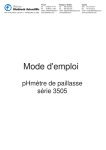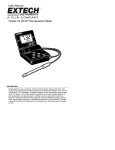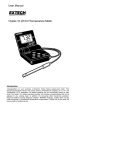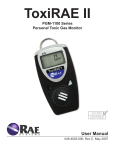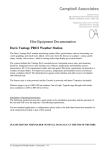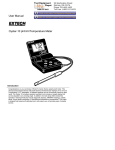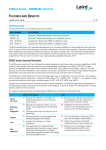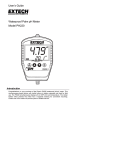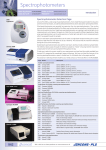Download MODEL 350 pH METER OPERATING MANUAL
Transcript
MODEL 350 pH METER OPERATING MANUAL 350 350/REV A/10-03 MODEL 350 pH METER OPERATING INSTRUCTIONS CONTENTS Introduction Specification Installation Displays Controls Operation Calibration Error Codes Manual Temperature Compensation Auto Shut Off Data Storage Good Practice Guidelines Maintenance Troubleshooting Guide Checking pH Meter Function Battery Replacement Optional Accessories EC Declaration of Conformity 1 1 2 2-3 4 5 5-7 8 8 8 9 10 11 12 13 13 14 15 MODEL 350 pH METER OPERATING INSTRUCTIONS INTRODUCTION The Model 350 is a general purpose hand held pH meter offering a 1 or 2 point calibration and automatic buffer recognition with manual override. The custom liquid crystal display simultaneously shows temperature compensated pH readings and the manually set temperature. The instrument is housed in a robust, ergonomically designed case. Calibration errors are clearly indicated together with the parameter in error. An indication of battery life is also permanently shown on the display. An automatic switch off facility helps to conserve battery life. SPECIFICATION pH Range: Resolution/Accuracy: Manual Temp. Comp. Range: Resolution: Auto Buffer Recognition: Calibration: Power: Battery Life: Size: Weight: (1 or 2 point cal) -2 to 16.00pH 0.01pH / ±0.02pH 0 to 100°C / 32 to 212°F 0.1°C / 1°F 4.00, 7.00, 9.22, 10.00 (manual override) User selectable 1or 2 pt 2 AA cells 500 hours typical (@ 25°C with alkaline cells) 175(l)x75(w)x35(d)mm 250g 1 INSTALLATION Unpack the instrument and ensure the following items are present: 1. Model 350 pH Meter (350 201) 2. Epoxy bodied combination pH electrode (924 001) 3. pH4, 7 & 10 buffer sachets 4. 2 x AA alkaline batteries (021 007)(fitted) Optional accessories which may have been ordered: Carry case (033 267) DISPLAYS 1. Main display - 3½ digit display providing direct readout of pH. Underrange (-1) and Overrange (1) symbols will be displayed if the instrument is reading outside the ranges of: pH -2.00 to 16.00 In addition, the instrument will display an erroneous result momentarily at the same time as the secondary display indicates the error code. 2 2. Secondary display - 4 digit display showing temperature compensation value in °C or °F. In the event of a calibration error the display will show an error code momentarily at the same time as the primary display indicates the erroneous reading. These codes will be shown as Err1, Err2 or Err3. 3. CAL 1 or CAL 2 indicator - shows which point of the calibration routine has been reached. 4. Battery Life Indication - 4 levels will be shown ranging from <25%, 25-50%, 50-75% and 75-100%. Sensor calibration data, user parameters and stored data are retained during battery replacement. 5. Mode annunciator. 6. MAN - this is displayed to indicate when auto buffer recognition is not being used. 7. RCL annunciator - this indicates that the displayed reading is a stored value recalled from memory. 3 KEYPAD CONTROLS STO RCL STO stores the current data reading. RCL enters recall mode to view the stored readings. I:O Switches the instrument on and off. This key should be pressed and held for 1-2 seconds to operate. The instrument will automatically switch off after 30 minutes if no key is pressed. Back light. Pressing this key will illuminate the back light for 10 seconds. It should be noted that, if used excessively, this will reduce battery life. 56 Enables manual setting of pH buffer values when performing a calibration, and adjustment of the manual temperature compensation value at other times. CAL This key is used to select and perform calibration in the pH mode. MODE This key allows selection of °C or °F when pressed for 3 seconds. 4 OPERATION Switch the instrument on by holding down the I/O key for 1-2 seconds. All display segments will be illuminated for approximately 2 seconds. An internal self check routine is run during this display and on successful completion normal operating mode is activated. Remove the electrode from the packaging and ensure it is in good condition. Connect the electrode to the instrument via the BNC socket and remove the wetting cap. Prior to performing sample measurement it is necessary to perform a 1 or 2 point calibration using the buffer sachet(s) provided. CALIBRATION The Model 350 features a one or two point calibration. For the best results we recommend that the 350 is calibrated with buffer solutions which are close to the sample value, where possible. For example: when working at 5.5pH we recommend calibrating at 7pH and 4pH. Auto buffer recognition operates over the range of 0 to 100°C, and will recognise 4.00, 7.00, 9.22 and 10.00pH. Alternative values may be entered manually during the pH calibration sequence by using the 56 keys to set the preferred values. It is important to enter the temperature of the buffer solutions prior to calibration as this value is used for the manual temperature compensation function. This will enable the auto buffer recognition feature to return the correct value for the buffer at the entered value (refer to the buffer value tables on buffers used). If the displayed reading is altered by using the 56keys during calibration the auto buffer recognition feature will be disabled. To retrieve the auto buffer recognition values it is necessary to exit the calibration sequence by pressing the MODE key. 5 Rinse electrode(s) in deionised water between measurements. To commence the calibration immerse the tip of the electrode into the first buffer solution so that the bulb and reference junction are covered. AUTOMATIC CALIBRATION FIRST POINT Press the CAL key and the display will show the CAL1 annunciator. The primary display will show a reading close to the buffer value based on the last successful calibration. For automatic calibration to one of the pre-programmed buffer values wait for the reading to stabilise and then press the CAL key again to update the display to the temperature corrected value for the buffer used (refer to the buffer value tables on buffers used). If a one point only calibration is required, pressing the MODE key will return the display to the pH measurement mode. The instrument is then ready to perform sample measurements. AUTOMATIC CALIBRATION SECOND POINT If a two point calibration is required the electrode should be rinsed and then immersed in the second buffer solution. The primary display will show a reading close to the buffer value based on the last successful calibration. For automatic calibration to one of the pre-programmed buffer values wait for the reading to stabilise and then press the CAL key again to update the display to the temperature corrected value for the buffer used (refer to the buffer value tables on buffers used). 6 MANUAL CALIBRATION FIRST POINT Press the CAL key and the display will show the CAL1 annunciator. The primary display will show a reading close to the buffer value based on the last successful calibration. For manual calibration press the 56keys to change the reading to the value for the specific buffer being used. When the correct value is achieved press the CAL key again to confirm this value. If a one point only calibration is required, pressing the MODE key will return the display to the pH measurement mode. The instrument is then ready to perform sample measurements. MANUAL CALIBRATION SECOND POINT If a two point calibration is required the electrode should be rinsed and then immersed in the second buffer solution. For manual calibration press the 56 keys to change the reading to the value for the specific buffer being used. When the correct value is achieved press the CAL key again to confirm this value. CALIBRATION COMPLETE For both automatic and manual calibration procedures the last (3rd) press of the CAL key returns the display to the pH measurement mode and sample measurement can proceed. 7 ERROR CODES Refer to Troubleshooting Guide for possible causes of error codes. If a problem is detected during calibration the following error codes will be displayed: Err1 This indicates that the calculated electrode offset at 7pH is outside the range of -30 to +30mV. The error code will be displayed for 3 seconds on the secondary display, together with the erroneous electrode offset value in mV on the primary display. The instrument will then reset the calibration data back to the ideal Nernst response of 0mV offset at 7pH and a slope of 59.16mV/pH at 25°C. Err2 This indicates that the slope value is out of range. The error code will be displayed for 3 seconds on the secondary display, together with the erroneous value as a % on the primary display. The instrument will then reset the calibration data back to the ideal Nernst response of 0mV offset at 7pH and a slope of 59.16mV/pH at 25°C. The allowable range for slope is 75% to 125% of the ideal Nernst figure. Err3 This indicates that the instrument has not recognised the buffer. The displayed reading must be within 1pH of the calibration buffer value for automatic buffer recognition. The error code will be displayed for 3 seconds on the secondary display, together with the erroneous pH buffer value on the primary display. The instrument will then reset the calibration data back to the ideal Nernst response of 0mV offset at 7pH and a slope of 59.16mV/pH at 25°C. MANUAL TEMPERATURE COMPENSATION Manual temperature adjustment must be made prior to commencing a calibration sequence or sample measurement. Pressing the 56 keys adjusts the temperature value. Temperature values can be displayed in °C or °F. Selection of the appropriate units can be made by pressing and holding the MODE key for 3 seconds. AUTO SHUT OFF This will occur after 30 minutes if no key is pressed. 8 DATA STORAGE The 350 can store up to 32 readings. Storage is intiated by manual key press. Storing Data Pressing the STO key stores the current reading in the next available data location. The storage location is indicated by Sto and a number (1-32) momentarily displayed for the data. The results are stored sequentially until the memory is full. When all 32 data locations are filled, the next stored reading will overwrite the result previously stored in position 1. The stored data is retained in the event of battery failure and during battery replacement. Recalling Data Pressing the RCL key recalls the last stored reading on to the display. The instrument is now in RCL mode, indicated by the RCL annunciator at the top of the display. The 56 keys are used to select previously stored data. The storage location is indicated by rCL and a number (1-32) momentarily displayed prior to the data. To clear all readings press and hold the CAL key (>3 seconds) while in RCL mode. When all stored readings are cleared the display will momentarily show CLr ALL. The instrument will then return to the main operating mode. If storage locations are empty and the RCL key is pressed, the display will show ALL CLr. NOTE: It is not possible to delete individual stored readings. 9 GOOD PRACTICE GUIDELINES The types of pH electrodes are many and various. The epoxy bodied combination electrode is suitable for the majority of tests carried out on aqueous solutions. For other applications, such as low ionic strength, high temperatures and strongly acidic solutions a more suitable pH/ reference electrode pair may be required. Details or advice supplied on request. The following general guidelines indicate the care and maintenance required: 1. After Use - Rinse thoroughly with distilled water. Short Term Storage - Immerse in storage solution (025 192) Long Term Storage - Fit wetting cap filled with storage solution (025 192) and replace in original packaging. 2. Electrodes should be stored: a) away from direct sunlight b) in a vertical position c) within their specified temperature range 3. Always ensure the electrode is used within its specified temperature range. Ageing of electrodes used above their specified temperature is rapid and irreversible. 4. DO NOT touch the sensitive glass pH membrane or reference junction. Excess droplets of solution may be removed by gently blotting with filter paper or tissue. DO NOT rub the electrode as this may induce an electrostatic charge. 5. During use ensure the electrode is rinsed between each measurement to eliminate the contamination of solutions. 10 MAINTENANCE CLEANING/RE-CONDITIONING OF GLASS ELECTRODES For general purpose use, combination electrodes can be cleaned with a mild detergent solution or a commercial glass cleaning solution (provided these are not strongly acidic). The electrode surface should be wiped with a clean cloth soaked in the cleaning agent, and/or allow the membrane to stand in the solution until clean. Rinse and repeat as necessary. TABLE FOR CLEANING OF GLASS ELECTRODES NOTE: The epoxy bodied electrode supplied with the instrument should not be cleaned with aggressive solvents. Deposit General deposits Inorganic coatings Metal compounds Oil/Grease Resins/Lignins Proteins (blood, etc) Stubborn deposits Cleaning agents Mild detergent solution Commercial glass cleaning solution (not strongly acidic) Acid solution, not stronger than 1M Complexing agent (EDTA) or suitable solvent Acetone, alcohol or detergent (not strongly alkaline) Enzyme solutions e.g. Pepsin in 0.1M HCl Weak hydrogen peroxide solution, Sodium Hypochlorite solution or domestic bleach. Electrodes which have been allowed to dry out, (often indicated by a hard, dry deposit of KCl crystals on the electrode body), should be rehabilitated by soaking overnight in warm deionised water. 11 TROUBLESHOOTING GUIDE FAULT PROBABLE CAUSE ACTION No power Battery failure Battery polarity incorrect Replace batteries Refit batteries Cal error 1, 2 or 3 Incorrect value buffer used Contaminated buffer solution Use correct value Use fresh buffer solutions Cal error 1 or 2 pH electrode defective Same buffer used for 2 point cal Replace pH electrode Recalibrate on 2 buffer solutions Unstable display pH electrode defective Replace pH electrode Display shows 1 or -1 only Intermittant or no connection pH electrode defective Contaminated solutions Check electrode connection to unit Replace pH electrode Replace solutions Intermittant display Probes not fitted correctly Check connections I/O switch not I/O key not held down >2 secs Retry holding key working for 2 seconds Fit batteries Batteries not fitted If a fault is identified during the start up self check routine an error code will be displayed. This indicates an internal hardware or software problem. In the event of this, please contact your local distributor or service agent. 12 CHECKING pH METER FUNCTION If the pH meter is considered to be defective the following procedure can be carried out to confirm this: Adjust temperature to 25°C using the 56 keys. Connect the meter to a mV source and apply 0mV. Press the Cal key and the display should read 7 pH. Apply +180mV and calibrate to 4 pH. Apply -180mV and the display should show 10 pH. If the above can be completed successfully the meter can be regarded as operating correctly and the electrode as suspect. This can be confirmed by re-calibration with a replacement or known good electrode. BATTERY REPLACEMENT If necessary, switch the unit off using the I/O key. To fit new batteries; loosen the battery compartment cover (the screws are captive in the cover), remove and carefully discard the used batteries. Fit the new batteries, type R6, AA or AM3, ensuring the correct polarities are observed, as indicated on the moulding. Refit the battery compartment cover, ensuring that the fixings are secured into place, but are not overtightened. 13 OPTIONAL ACCESSORIES The following list of items are available for use with the Model 350: 033 267 Carrying Case 025 179 pH 4 buffer sachets (pack 10) 025 180 pH 7 buffer sachets (pack 10) 025 181 pH 10 buffer sachets (pack 10) Electrodes and consumables are available for use with this product. Details available on www.jenway.com. SPARE PARTS Epoxy bodied pH electrode Battery (Qty 1) 924 001 021 007 Recommended spares list for 2 years: Batteries (Qty 8) Epoxy bodied pH electrode (Qty 2) 14 021 007 924 001 EC Declaration of Conformity JENWAY Model 350 pH Meter complies with the following European Standards: EN 50081-1:1992 Electromagnetic compatibility - Generic emission standard EN 61326:1998 Electrical equipment for measurement, control and laboratory use - EMC requirements EN 61010-1:1993 Safety requirements for electrical equipment for measurement, control and laboratory use Following the provision of: EMC Directive - 89/336/EEC and Low Voltage Directive - 73/23/EEC Carl Warren Technical Manager, Jenway Gransmore Green, Felsted, Dunmow, Essex, CM6 3LB, England 15





















